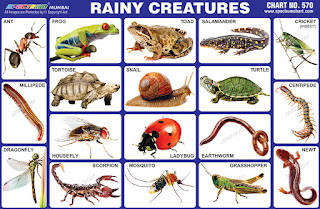 |
| Rainy Creatures Chart |
Spectrum Chart - 570 : Rainy Creatures
1. Ant - Ants range in size from about 2
mm to 25 mm. Their colour is usually yellow, brown, red or black.
Ants are most common insects found in every neighbourhood.
2. Millipede – Millipedes are a very
long type of arthropod. Millipedes are segmented. Most have between
20 to over 100 segments and have flattened bodies. Except for the
first few segments, each segment has 2 pairs of legs. Most millipedes
are poisonous.
3. Dragonfly - Dragonfly is mostly found
hovering near lakes and swamps.The dragonfly is best known for its
beautiful colours and the way it's body and wings sparkle when the
dragonfly is flying around the water.
4. Frog - Frogs are a diverse and largely
carnivorous group of short-bodied, tailless amphibians composing the
order Anura. Frog have long hind legs, elongated ankle bones, webbed
toes, no claws, large eyes and a smooth or warty skin. Like other
amphibians, oxygen can pass through their highly permeable skins.
5. Toad - Toad is an amphibians that are
characterised by dry, leathery skin, short legs and parotoid glands.
Toad can reach about 15 cm in length. Toads can live for many years
and have survived for fifty years in captivity.
6. Salamander - Salamander is a type of
amphibian, close relative of frogs and toads. They live mostly in the
northern hemisphere, in the wet areas near the lakes and ponds. There
are 500 known species of salamanders. Salamanders look like lizards
because of their long and slim body, but unlike lizards they have
smooth and glossy skin.
7. Tortoise - Tortoises is a land-dwelling
reptile. Tortoises have a hard outer shell to protect them from
predators.The tortoise's shell can range in size from a few
centimetres to a couple of metres, depending on the species of
tortoise. Tortoises have one of the longest lifespans of any animal,
some individuals are known to have lived longer than 150 years.
8. Snail - Snail is a common name for a
kind of mollusc. Snails are invertebrates, means animals with no
backbones. The shell on the snail helps protect it and also reduces
the loss of water by evaporation. Shells have many different shapes,
sizes, and colours. Snails do not breathe through their mouths,
instead they have a breathing hole under their shells.
9. Turtle - Turtles are reptiles having a
hard shell that protects them like a shield, this upper shell is
called a ‘carapace’. Many turtle species can hide their heads
inside their shells when attacked by predators. Turtles spend large
amounts of their lives underwater.
10. Housefly - House Fly, is the most
familiar species of non biting muscoid fly, found in the vicinity of
human habitations throughout the world. It is often a carrier of
diseases such as typhoid fever, cholera, dysentery etc.
11. Ladybug - Ladybug is less than 1.2 cm
in maximum length. It has a nearly hemispherical body, rounded above
and flat below, a small head and short legs.
12. Earthworm – An earthworm is an
invertebrate animal with a long, stretchy body and no legs. It is a
type of annelid. Earthworm is a reddish brown in colour, with a
pointed posterior and anterior end. Earthworms have no lungs and
absorb oxygen directly through their skin. Earthworm's diet is
decaying matter, leaf litter, microbial fungi and other microscopic
organisms.
13. Scorpion - Scorpion belongs to group
called arachnids. There are 1200 species of scorpions that can be
found all over the planet. Scorpions use pincers to grab its prey.
Venom is used both for attack and for defence. Scorpions are
carnivores. They usually feed on insects. Scorpions do not drink much
water and they can survive very long time without water.
14. Mosquito - Mosquitoes are small,
midge-like flies. They are responsible for transmitting extremely
harmful infections such as malaria, yellow fever, dengue fever and
other arboviruses.
15. Grasshopper - Grasshopper are
distributed worldwide wherever vegetation grows. Grasshoppers are 3
to 13 cm (1 to 5 in) long when fully grown. Adult Grasshoppers can
also fly.
16. Cricket - Crickets vary in length from
3 to 50 mm. They have thin antennae, hind legs modified for jumping,
three-jointed tarsal (foot) segments and two slender abdominal
sensory appendages.
17. Centipede - Centipede is an arthropod
with many legs. Centipedes are predators. They hunt during the night,
they are nocturnal. Some centipedes are venomous, though none can
kill a human. They have between 5 and 173 segments, but only one pair
of legs per segment. There may be 8,000 species of centipedes in the
world.
18. Newt - A newt is a semi aquatic
amphibian of the family Salamandridae. They can be found in North
America, Europe and Asia. Adult newts have lizard-like bodies and may
be either fully aquatic, living permanently in the water or
semi aquatic, living terrestrially, but returning to the water every
year to breed.

No comments:
Post a Comment